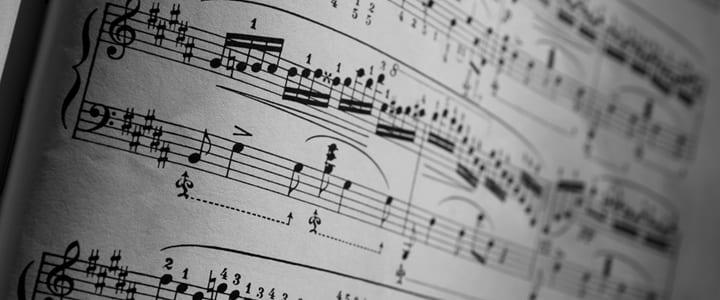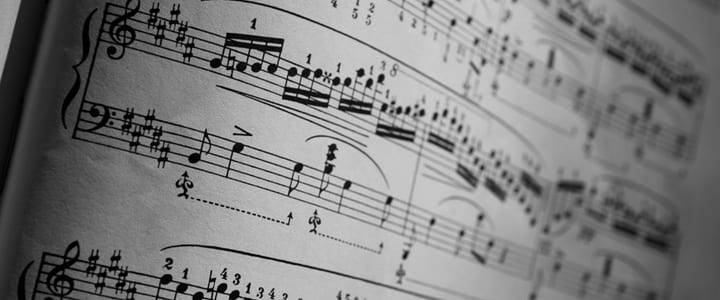Want to learn about writing your own piano scores? Find out how to get started in this guest post by New Paltz, NY teacher Cheryl E...
Being a pianist comes in very handy–and not just at family holiday parties when your in-laws are bellowing “Deck The Halls” in your ear as you try to keep some sense of rhythm. The piano is a versatile instrument that allows even the most novice composers to explore a full spectrum of dynamics, textures, and pitch range.
No matter what you’re composing for, the foundation is always based in enhancing the experience. Piano scores, for example, are pieces of music that are written to enhance a moving image, whether that’s a film, a commercial, or any other type of video. To get started, we’ll take a look at a few key elements that will shape your process:
1) Do you have video to work with, or just a concept? If you have the video in its final version, then you have some limitations regarding the tempo. You may need to emphasize a brand’s logo as it appears, or you may want to pause for a punch line. Working backwards and timing your piece from key moments is often the easiest way to set your tempo. If you do not have a video to work with, you have a bit more freedom to write a piece of music that will fit the creative direction your client has given you.
2) Do you have a creative direction? The creative brief is often the most important conversation you can have as a composer with a new client. I look at being a composer as a way to help the director, producer, or agency tell their story. Here are my three key questions that I always ask a collaborator if they don’t have a specific idea of what they want:
- What are 5-10 words that you would use to describe the story, the video, the feel, and the vibe of the piece? As the composer, you can then act as translators, taking their words and sculpting them into the final piano score.
- What do you want your viewer to feel or do? Feel inspired? Be so excited they go out and buy something? Feel nostalgic? Your score can help lead to these desired results.
- Are there any songs or genres of music that have been in the back of the creators’ minds that could work? Anything that would definitely NOT work?
3) Will your score be for piano only, will it be written for other live instruments, or will you be using computer software to create most of the body of the music? (My favorite composing software, and an advertising and film industry standard, is Logic X.) Here are a few considerations for each of these options:
- Writing for piano only, you will want to see how much dialogue or voice-over is in the video. If there is quite a lot of talking, you won’t want the middle range of the piano (the typical range of a speaking voice is from about middle C to A 440) to compete. You can also use an equalizer in the mix to mitigate any competing frequencies, but that’s a whole other article.
- If you are writing on the piano initially, with the knowledge that you will be arranging your piece for other instruments, make sure you know the range of each instrument you’re writing for. It’s always a drag to get to a live session, pass out your sheet music (I use Finale to transcribe my pieces) and have the cellist tell you their instrument can’t play the notes you wrote.
- Writing “in the box,” as in, using mostly or all software instruments, is the option I use most often. It is the fastest way to get a track completed from start to finish. When working with piano in a software system, you can play in all your parts, and then assign each part to a software instrument of your choosing. This process has the added task of mixing so that it sounds authentic and “non-synthy.” Giving each instrument space (by panning, EQ-ing and working with reverb and compression) is key to writing ear-pleasing piano scores. (Again, I could go on for days about this.)
Once you have a strong grasp on the video’s concept and story, the musical creative direction, and your choice of instrumentation, you get to start the fun part: composing! It’s a privilege to provide a creative service that also allows someone else to express their story, their brand, or their ideas, all while crafting a purely enjoyable experience for future viewers and listeners.
 Cheryl is a film and TV commercial composer and singer/songwriter with multiple tours, records, and TV placements under her belt. If you turned on your television this year, you’ve definitely heard her music. She teaches piano and voice in addition to composition and arrangement in New Paltz, NY. Learn more about Cheryl here!
Cheryl is a film and TV commercial composer and singer/songwriter with multiple tours, records, and TV placements under her belt. If you turned on your television this year, you’ve definitely heard her music. She teaches piano and voice in addition to composition and arrangement in New Paltz, NY. Learn more about Cheryl here!
 Photo by MaxiuB
Photo by MaxiuB
Suzy S.

